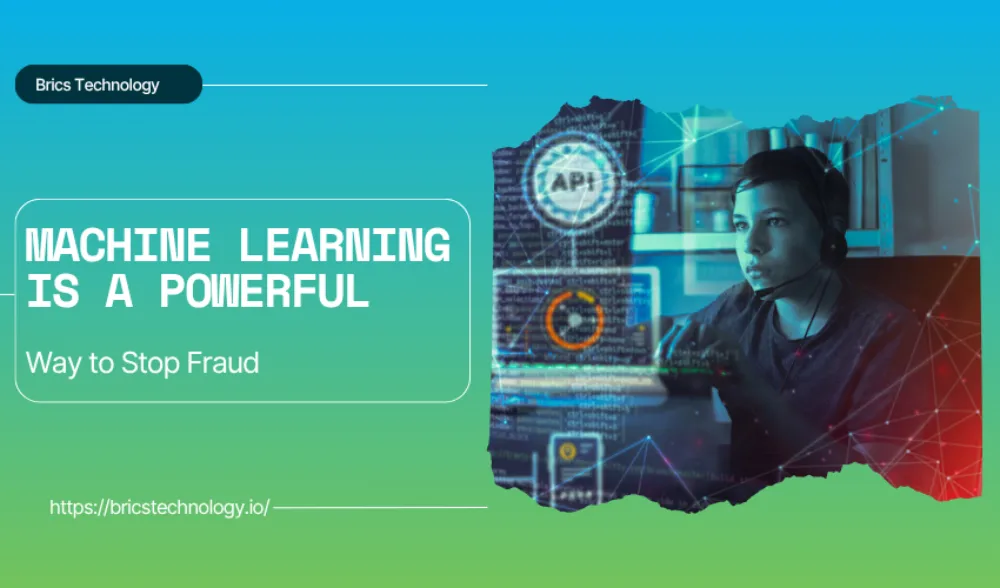Machine Learning is a Powerful Way to Stop Fraud

Where transactions occur in seconds and online economic activity thrives, fraud requires close attention in a fast-paced digital world. This is where Machine Learning comes in. It gives us tremendous tools to find and stop fraud. Machine Learning revolutionizes the way companies and financial establishments protect themselves and their clients.
What Exactly is Machine Learning?

Machine learning, at its core, is a branch of artificial intelligence (AI) that enables computer structures to “research” information without explicit programming. Imagine teaching a child to recognize animals. Instead of giving a strict rule for every animal (“A dog has four legs and barks”), you simply show them many pictures. The child gradually begins to develop the ability to recognize styles and differentiate between the various animals.
Machine learning works in a comparable way. Human programmers do not write countless lines of code to identify each possible fraud scenario; instead, we input vast amounts of historical data into machine learning models. This record includes both legitimate and fraudulent transactions.
Understanding the Role of Machine Learning
Recognizing the connection between artificial intelligence and machine learning is important. Consider AI to be the larger discipline, including all methods that enable a computer system to simulate human intelligence. Machine learning is a crucial subset of AI. While AI pursues creating sensible machines, machine learning offers the techniques and algorithms for those machines to study, enjoy, and improve their performance over time.
In the context of fraud detection, AI provides the overarching framework for shrewd decision-making, while machine learning is the engine that drives this intelligence. For instance, an AI gadget might be designed to make real-time selections about approving or declining transactions. The machine learning component within that AI machine would be responsible for constantly mastering new transaction information, updating its knowledge of what constitutes fraud, and feeding the insights back to the AI device to enhance its choice-making accuracy. This synergy makes for a sincerely robust and adaptive fraud detection gadget.
Machine Learning Applications in Fraud detection

The realistic applications of machine learning in fraud detection are significant and continuously increasing. Here are a few key regions wherein it is making a good-sized impact:
Credit Card Fraud Detection: This application is one of the most common and significant uses of Machine Learning. Machine learning models examine considerable quantities of transactional statistics, inclusive of buy history, vicinity of transactions, time of day, and spending patterns. If a transaction deviates notably from a customer’s typical behavior—as an instance, a large purchase made out of the country when they normally simply save locally—the system can flag it as suspicious for further research or even decline it straight away. Such an approach dramatically reduces the window of opportunity for fraudsters.
Insurance Claim Fraud: Insurance companies lose billions yearly to fraudulent claims. Machine learning algorithms can examine declaration forms, clinical information, beyond declaration history, and even publicly available records to pick out patterns indicative of fraud. For example, an unexpected increase in claims from a particular location after a “minor” incident, or steady claims for similar accidents from distinct individuals related to the identical deal, could trigger This enables insurance providers to more effectively identify and investigate suspicious claims, thereby preventing significant financial losses.
Online Banking and Account Takeovers: With the upward push of online banking, account takeovers are a first-rate challenge. Machine Learning can screen login tries, tool data, IP addresses, and consumer conduct patterns. If there’s an unusual login strive from a new tool or a suspicious location, or if the consumer’s regular sports abruptly exchange (e.G., massive transfers to new beneficiaries), the gadget can flag it. Multi-factor authentication, often prompted by way of such Machine Learning alerts, provides a further layer of safety, defensive customers’ economic money owed.
Money Laundering Detection: Money laundering entails making illegally won money appear valid. This activity regularly involves complex transactions and networks. Machine learning can analyze large datasets of economic transactions to identify unusual patterns of cash movement, complex network systems, and relationships among individuals or entities that may indicate money laundering activities. It facilitates financial institutions meeting regulatory requirements and fighting monetary crime extra efficiently.
E-commerce Fraud: Online retailers face a constant battle against various forms of fraud, which include chargebacks, faux critiques, and identity theft. Machine Learning can analyze patron behavior on websites, order information, transport addresses, and fee information to pick out purple flags. For instance, more than one order for extraordinary money owed to the same transport address, or unusually large orders from new customers, may be detected and investigated. This process allows e-commerce agencies to decrease monetary losses and hold customer trust.
The Future of Machine Learning in Fraud detection
The landscape of fraud is ever-changing, and so too is the function of getting to know the device in combating it. The future promises even more advanced applications and improvements.
One key trend is the circulation in the direction of real-time fraud detection. As machine mastering fashions emerge and greater green and computing power increase, the ability to analyze transactions and make choices in milliseconds will become well-known. With this method, we can stop fraud before it even completes, supplying unparalleled protection.
Another area of growth is the integration of various data sources. Currently, machine learning models generally rely upon transactional facts. In the destiny, they will probably comprise even extra various statistics, along with social media pastimes, public information, and even biometric facts (with appropriate privateness safeguards), to build a more comprehensive image of person conduct and perceive anomalies. This comprehensive approach will make it more difficult for fraudsters to evade detection.
Conclusion
In conclusion, system gaining knowledge is now not only a buzzword; it is an indispensable tool in the combat against fraud. Its potential to learn from data, identify complex patterns, and adapt to evolving threats makes it uniquely suited for safeguarding our financial systems in the digital age. As the machine mastering era continues to boost, we are able to sit up for a destiny in which fraud is not eliminated absolutely but is, however, appreciably reduced, leading to more safety and belief in our increasingly more interconnected world.
Catagories
Recent Post
- From Biometrics to Blockchain: Reinventing Identity Verification
- From Idea to Income: How to Build and Sell AI Soulmates
- Supporting Employee Wellbeing in the UK: What Businesses Often Overlook
- The Role of AI Development Companies in Enhancing Security for Brics Coin Transactions
- Designing Smart Cancellation Flows: Best Practices for SaaS
